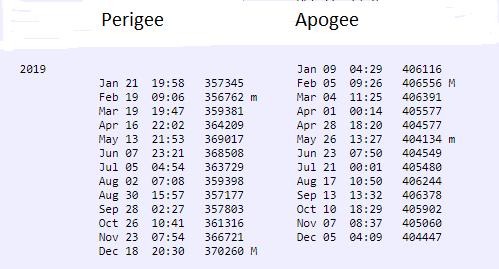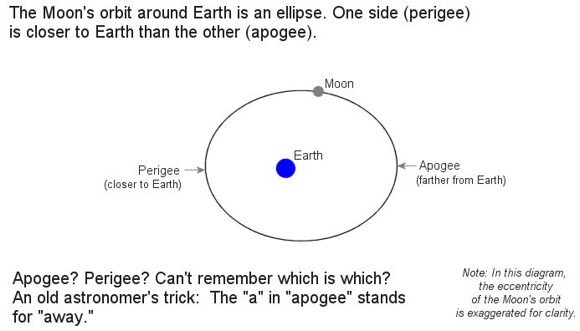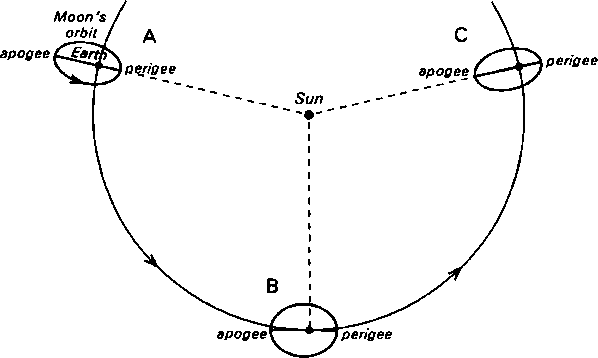Image above: The moon’s orbit around Earth isn’t a perfect circle. But it’s very nearly circular, as the above diagram shows. Diagram by Brian Koberlein.
The moon sweeps to perigee – its closest point to Earth in its orbit – on December 18, 2019. This perigee counts as the most distant of this year’s 13 perigees. So you might say today’s moon is the farthest close moon. Notice … this most distant perigee comes when the moon is near last quarter phase. That is not an accident. More below.
How far away is the moon today? It’s 230,072 miles (370,265 km) distant. That’s in contrast to 2019’s closest perigee of 221,681 miles (356,761 km) on February 19.
If you’re game, we’ll share a secret with you about why a quarter moon at perigee is farther than the mean perigee distance of 225,804 miles or 363,396 km, and why a quarter moon at apogee is closer than the mean apogee distance of 251,969 miles or 405,504 km. We’ll also explain why a full moon or new moon at perigee is closer than the mean perigee, yet why a full moon or new moon at apogee is farther than the mean apogee. It all has to do with the varying eccentricity of the moon’s orbit.
EarthSky 2020 lunar calendars are available! They make great gifts. Order now. Going fast!

The moon’s eccentric orbit
The moon’s orbit around Earth, like Earth’s orbit around the sun, isn’t a perfect circle. It’s a slightly oblong ellipse. That’s why, every month, the moon reaches a nearest point to Earth at perigee and a farthest point at apogee.
However, the moon’s orbit isn’t highly eccentric (oblong), but nearly circular, as shown on the illustration above.
What’s more, like everything else in nature, the moon’s orbit is always in flux. Its shape and its orientation relative to the Earth and sun change all the time.
So we have a moon at perigee – closest to Earth for the month – and also a moon at its last quarter phase only 1/3rd day later.
Lunar perigee: December 18, 2019, at 20:30 UTC
Last quarter moon: December 19, 2019, at 04:57 UTC

The illustrations above label perigee (moon’s closest point to Earth) and apogee (moon’s farthest point from Earth). A line drawn from perigee to apogee defines the major axis, or the longest diameter, of the moon’s elliptical orbit. In the parlance of astronomers, the perigee-to-apogee line is called the line of apsides. The center of the line of apsides to either the perigee point or apogee point is called the semi-major axis.
Earth does not lie at the center of the line of apsides. Instead, the Earth is offset from the center of the major axis, or line of apsides, toward the lunar perigee point. To be more precise, the Earth resides at one of the two foci of the ellipse.
Keep in mind, also, that the moon’s major axis (longest diameter of an ellipse) always makes a right angle to the moon’s minor axis (shortest diameter of an ellipse).
Varying eccentricity of the moon’s orbit
When the moon’s major axis, or line of apsides, makes a right angle to the sun-Earth line (B in below diagram), the moon’s eccentricity decreases to a minimum. In other words, the moon’s orbit is closest to being circular when the moon’s minor axis points toward the sun. Although the moon still swings closest to Earth at perigee and farthest from Earth at apogee, the perigee distance increases and the apogee distance decreases whenever the moon’s eccentricity lessens, or more closely approaches a circle in shape.
In short, when the major axis makes a right angle with the sun-Earth line (B in below diagram), the quarter moons closely align with perigee and apogee.

Some 103 days before and after the minor axis points sunward (B in above diagram), it’s then the moon’s major axis that points in the sun’s direction (A and C in above diagram). When the major axis, or line of apsides, aligns with the sun-Earth line, the eccentricity of the moon’s orbit increases to a maximum, and its orbit becomes maximally oblong. That causes the moon to swing extra-far from Earth at lunar apogee – yet extra-close to Earth at lunar perigee.
And that brings us to the full moon. It’s also no accident that 2019’s closest perigee closely aligned with the full moon.
Lunar perigee: February 19, 2019, at 09:06 UTC
Full Moon: February 19, 2019, at 15:53 UTC
When the major axis points sunward (A and C in above diagram), it’s the new moon or full moon that closely aligns with perigee/apogee. In diagram A, it’s a new moon perigee and full moon apogee; and in diagram C, it’s a full moon perigee and new moon apogee.
Farthest perigees often recur in cycles of 14 lunar months (14 returns to the same lunar phase), a period of about 413 days (1 year, 1 month and 18 days). For instance, 14 lunar months ago (from December 18, 2019), the close coincidence of last quarter moon with perigee presented last year’s farthest perigee on October 31, 2018, (230,072 miles or 370,265 km). Moreover, 14 lunar months from today (December 18, 2019), the last quarter moon will again closely align with perigee, to stage the following farthest lunar perigee of the cycle on February 3, 2021, (229,986 miles or 370,127 km).
Want to know more? Eclipses and the moon’s orbit
Resources:
Lunar perigee and apogee calculator
Moon at perigee and apogee: 2001 to 2100
Phases of the moon: 2001 to 2100
Bottom line: In 2019, the moon swings to its most distant perigee of the year on December 18, 2019.











